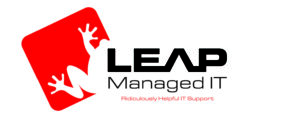By Gary Thomas and Michael Thomas, Owners, LEAP Managed I.T.—
MUNCIE, IN—Easter morning several years ago, we got the call first from our network operations team at LEAP Managed IT, where we provide managed IT services and cybersecurity solutions to businesses across the Midwest, then from the business owner themselves. Their servers had gone silent. Moments later, the owner stood in the parking lot, watching smoke pour from their building, surrounded by first responders.
We arrived shortly after, pulling damaged computer equipment from the smoke-filled facility. Thankfully, their critical data had been backed up to the cloud. But recovery wasn’t immediate. Restoring access, setting up temporary infrastructure, and replacing burned-out workstations took time. Meanwhile, the business faced urgent, non-technical challenges:
- How do employees access critical files?
- Where can the team work?
- How do we process payroll or answer customer calls?
- Who contacts vendors, legal teams, and insurers?
The good news? This client had a solid disaster recovery plan in place spanning IT, insurance, and pre-established relationships with financial partners. They executed a three-phase facility recovery: moving into a temporary site within two weeks, a larger intermediate site for two years, and eventually a new permanent facility. It was a lot of work but they were ready.
Not all stories start with a building emergency. At LEAP Managed IT, we’ve been called in during some of our clients’ toughest, most heartbreaking moments: abrupt executive terminations, unexpected deaths of business owners, and ransomware attacks. These moments are chaotic and emotional. And without a plan, they can bring operations to a halt. In many organizations, critical knowledge resides with just one leader. When that person is suddenly gone, so is their insight into how the business runs.
Whether it’s a flood, cyberattack, natural disaster, or leadership crisis disasters strike in many forms. Across our work with city governments, accounting firms, ag-tech companies, and countless others throughout the Midwest, we see one universal truth: planning ahead makes all the difference.
Why You Need a Disaster Recovery Plan
Disaster recovery planning isn’t just a tech checklist, it’s a business critical necessity. But many leaders still avoid it. Some don’t know where to start, others assume it’s too complex, and many simply put it off for “someday”. The result? They’re unprepared when the unexpected hits.
The truth is, getting started doesn’t need to be overwhelming. A strong plan doesn’t have to be perfect it just needs to exist and evolve over time. At LEAP Managed IT, we regularly help organizations lay the foundation in just a couple of hours. You’d be surprised what your team can uncover and prepare for in a single session.
Expert Insight: Insurance Isn’t Optional
To understand what role insurance plays in disaster planning, we turned to Lori Rowan, a Partner at Zeller Insurance, a leading independent insurance agency based in Columbus, Indiana. With decades of experience advising business clients across the Midwest, Lori brings deep expertise in preparing companies for the unexpected.
“One of the most common gaps I see is in business income or loss of rent coverage,” Lori explains. “Many businesses don’t specifically insure their computers and software—they’re covered under general Business Personal Property, which can be very limited when it comes to a disaster.”
She also warns that businesses often overlook critical policies like cyber liability, equipment coverage, and key person life insurance.
“Cyber coverage is essential in this day and age. It can be surprisingly affordable, and the risk of attack is only growing. For leadership continuity, key person life insurance is a must if your business depends on one or two individuals.”
Lori also advises businesses to prepare detailed documentation in advance. After a disaster, insurers typically ask for:
- Historical financials to verify income loss
- Inventories of hardware and software assets
- Documentation of physical and digital infrastructure
“One of the simplest and most effective steps any business can take today,” Lori says, “is to create a video inventory of their entire space. It helps tremendously during the claims process and ensures nothing gets overlooked.”
Her additional tips for small businesses:
- Use a password manager to access critical sites quickly
- Maintain updated records of tech equipment, including contractors’ tools
- Ensure you have a plan and the short-term funds to reopen quickly
“Business income coverage is usually inexpensive,” she adds. “But without it, your ability to restart operations could be seriously delayed.”
6 Essential Steps to Building a Disaster Recovery Plan
- Assess Risks and Scenarios
Identify the threats most likely to impact your business from natural disasters to cyberattacks to leadership turnover. - Inventory Critical Systems and Processes
List essential IT systems, physical files, operations, and personnel roles necessary to keep your business functioning. - Define Roles and Responsibilities
Establish a chain of command and assign recovery tasks so there’s no confusion in a crisis. - Document Communication Plans
Plan how you’ll notify employees, clients, vendors, and partners during and after an incident. - Develop and Test the Recovery Plan
Outline step-by-step procedures for restoring systems and services. Test the plan regularly with tabletop exercises. - Keep the Plan Updated
Review and revise the plan annually or whenever significant changes happen in your business.
Ready to Protect Your Business? Start with Our Free Workshop
At LEAP Managed IT, we’re offering a no-cost, no-obligation Disaster Recovery Planning Workshop to help organizations take the first step. Visit leapmanagedit.com/events to sign up.
About LEAP Managed IT
LEAP Managed IT is a trusted technology partner helping organizations across Indiana and the Midwest achieve stability, security, and scalability through smarter IT. We specialize in managed IT services, cybersecurity, cloud solutions, compliance, and strategic technology planning, supporting clients in industries like healthcare, finance, government, and professional services. Visit leapmanagedit.com and leapcopierprinter.com for more information
About Zeller Insurance
Zeller Insurance is a full-service, independent insurance agency based in Columbus, Indiana. Family-owned and community-focused since 1964, Zeller serves businesses and individuals with custom commercial insurance, risk management strategies, and personal coverage plans. Their team of experienced agents, including Partner Lori Rowan, is known for providing personalized service and proactive guidance when clients need it most. Visit zellerinsurance.com for more information.





